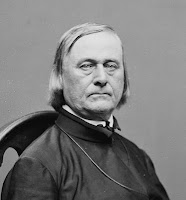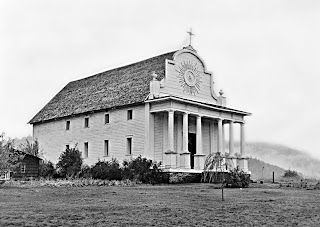 |
| Father De Smet, 1860-65. Library of Congress, Brady-Handy Photograph Collection. |
In 1840, Father de Smet joined a party of American Fur Company traders headed for a mountain man rendezvous on the Green River in Wyoming (the last such gathering, as it turned out). From there, some Flathead Indians led him to a large Indian encampment at Pierre’s Hole (today’s Teton Valley, Idaho). There, Flathead, Pend Oreille, and Nez Perce tribesmen responded enthusiastically to his preaching and instruction. Later, he preached to attentive audiences near Three Forks, in Montana.
Encouraged, de Smet returned with a group the following year. On that trip, the Bartelson-Bidwell emigrant party accompanied de Smet’s missionaries as far as Soda Springs [blog, Aug 8]. The Bidwell expedition was the first company of Americans to emigrate to California by wagon train.
Father de Smet’s group reached Fort Hall after nearly four months on the trail. Glad of the respite, de Smet stopped to rest and repair equipment. The factor even sold him supplies at bargain prices, a major concession since everything had to be laboriously packed in from their base on the Pacific Coast.
After a few days, they continued into Montana. There, the Catholics built St. Mary’s Mission, 25-30 miles south of today’s Missoula. That fall, Father de Smet traveled even further west at the invitation of Dr. John McLoughlin, Chief Factor of the Columbia Division of the Hudson’s Bay Company [blog, Oct 19].
 |
| Kalispel teepee and canoe on the Pend Oreille, ca. 1860. Bonner County Historical Society. |
On his way to Fort Colville, Father de Smet encountered a band of Kalispel Indians. Though lacking in height, the good Father possessed an impressive physical presence and abundant charisma. His three-day sojourn planted more seeds. Word of the “Black Robe’s” mission quickly spread among the tribes of North Idaho.
When he returned in the spring, he met with more Kalispels, as well as Indians from the Kootenai and Coeur d’Alene tribes.
Fulfilling a promise made by Father de Smet during those meetings, Father Nicholas Point and Brother Charles Huet soon came among the Couer d’Alenes to build a mission church. Their choice of location proved inauspicious: floods inundated the site in the spring. Father de Smet selected a new location about 8 miles west of the later town of Kellogg.
 |
| Sacred Heart Mission church, Cataldo, Idaho, 1957. Library of Congress. |
The Mission of the Sacred Heart was moved to near today's Cataldo, in 1846. Four years later, Father Anthony Ravalli arrived to design and build a new church for the mission.
Constructed with simple hand tools, the timber-frame structure contained no nails and took three years to complete. It is the oldest building in the state. (Designated a National Historic Landmark in 1961, it was among the sites automatically included when the National Register of Historic Places was created in 1966.)
Father de Smet spent the rest of his life striving, with little long-term success, to maintain peace between whites and the tribes of the Northern Plains. For his day, de Smet traveled an incredible amount: The equivalent of over seven times around the Earth, soliciting funds and new recruits. He passed away in St. Louis, in May 1873.
| References: [Brit] [Hawley] |
| Robert C. Carriker, Father Peter John De Smet: Jesuit in the West, University of Oklahoma Press (September 1998). |